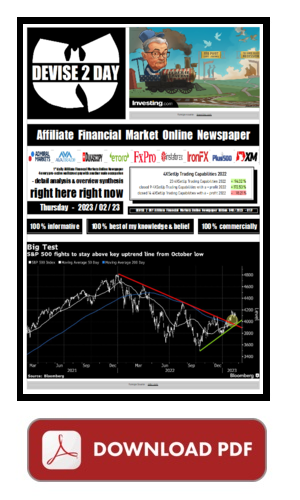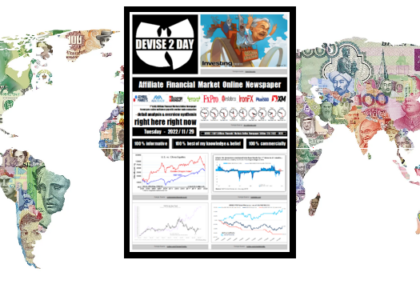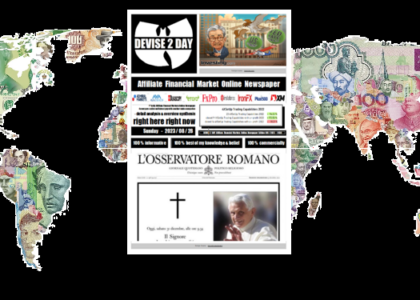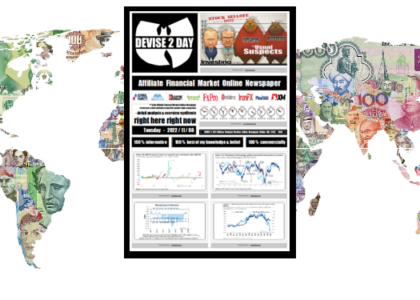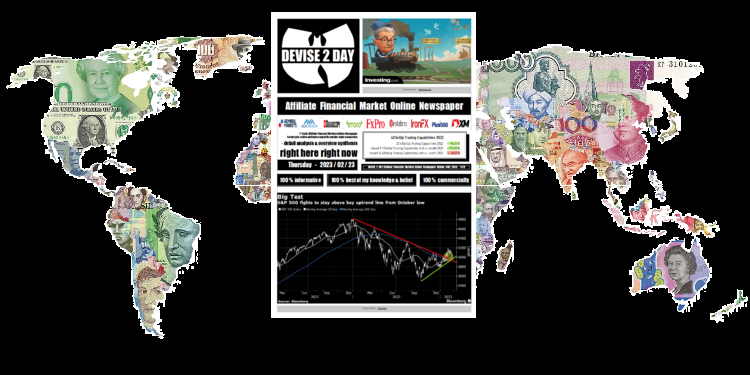
2023/02/23 (177) Column
Out Of stagflation?
This Is The Roadmap To Recovery!
Since July 2021, the USA has been in facto stagflation – inflation is higher than growth.
Without wanting to give a professorial lecture at this point as to why stagflation is harmful to any economy, I would like, in this column, to point out that the gap between Wall Street and/or Main Street widens during stagflation. Because prices are rising faster than total value. Certain products and/or services – which were previously accessible to everyone and were cheaper – become so expensive that the so-called average citizen cannot afford them, does not want to afford them. Because his wages don’t rise as much – just the total GDP. To get rid of one more basic sentence; we have to produce more goods and offer more services than the market – in this case we taxpayers and consumers – need. So that prices fall, GDP grows again.
That`s why I now also assume that in 2023 we will have the weakest annual global economic growth in the past 40 years. Except for the global financial crisis of 2008 and/or the time of the Covid restrictions in 2020. As this year 2023 is likely to be a shallow global recession! What do I mean? GDP growth in the 4 quarters of 2023 compared to the same quarter of the previous year between +1% & -1%. However, this can be worse in some regions, such as the United Kingdom, as well as in individual countries in the euro zone. I expect a better recovery for China than here in the so-called West. However, only as soon as the pandemic restrictions there are relaxed.
I also assume that there will be a further slowdown in inflation in the US.
And with that, a gradual reduction in interest rates by the FED, possibly in 2024.
Which should then also be accompanied by a higher GDP at the same time. So that, at least in the USA, in the coming year 2024, sooner or later, more or less, we are likely to grow out of stagflation again.
For the stock market, I expect an average 10% decline in global earnings per share for this year 2023.
Therefore rely on various individual stock markets – and/or also stocks that, due to their profitability, thanks to a cash flow, fundamentally became cheaper. Because in the historical context, this year 2023 could also be something like a long-term 4XSetUp. But I don’t want to think that far today. Because getting out of stagflation can only work if GDP grows faster again. And the market, as the majority of financial market participants, should then slowly start to concentrate on this in the second half of 2023 at the latest. From July 2023! Why? Because, if I’m not mistaken, and or the FED will have done its homework, by the end of June 2023 at the latest, the FED’s interest rate should finally be higher again than the then current US inflation…DEVISE 2 DAY 48h
– Last News About What Drives The News Media
On the anniversary of the invasion of Ukraine, the military leadership in Kiev reports that the Russian armed forces have suffered heavy losses. Since the war began on February 24 last year, 145,850 Russian soldiers have been killed, 790 of them on Wednesday alone, according to Thursday’s list. There is no current official information from Moscow on this, nor are the losses on the Ukrainian side known. The list of casualties suffered by Russian attackers, which is updated daily by the Ukrainian side, also includes 299 warplanes, 287 helicopters and 3,350 battle tanks destroyed or captured. In addition, 2,352 Russian artillery systems were destroyed. Neither this information nor that of the soldiers killed can be independently verified. Most recently, in December, Russia had named 6,000 losses on its own side. American estimates assume that around 200,000 Russians have been either killed or wounded in Ukraine so far. Conversely, at the end of the year, the leadership in Moscow spoke of more than 60,000 Ukrainian soldiers killed, while in Kiev there was talk of around 13,000.
DEVISE 2 DAY Another 48h
– Last News About How Drives The Price Action
NVIDIA’s encouraging results and prospects are gratifying, which in turn is pulling shares in other chip stocks higher as well. ETSY shares are also trending friendly. Whatever the case, by far the most earnings and outlook are weak, with prices falling across the board. Bumble, Cheesecake Factory, Domino’s Pizza, Ebay, Lucid, NetApp, Teladoc, and Unity Software are all trending weaker according to the numbers. Until we see a pullback in US Treasury yields, any recovery attempts are on thin ice. I continue to feel more comfortable on bonds than on the equity side. Not least because of the valuation achieved, which applies in particular to NVIDIA shares.
Today’s first page i illustrated with a chart from bloomberg about the sp500. Because I also think that the Sp500 is currently being technically traded at a crucial crossroads. And I mean this with regard to the 3900 and or but also 3800 Price Action Zone. Because if she doesn’t act, cops could psychologically capitulate again; losing faith that the SP 500 will return above 4000 points as soon as possible. Which also implies downside potential old new lows.
JPMorgan Chase strategist Marko Kolanovic said he is “turning more defensive,” recommending that investors fade this year’s stock rally because “a recession is currently not priced into equity markets.” Which I agree.. Because I assumed we would see a brief spike in inflation, like with the unemployed, during the Corona Virus outbreak. But the latest inflation data scared me; to remain bullish. Hence the rice line at 34,000 points in the Dow. And or at the latest at 3900 and 3800 in the SP500, for the next few weeks and months. As inflation is likely to be the cause of a (not) imminent recession.
“With equities trading near last summer’s highs and at above-average multiples, despite weakening earnings and the recent sharp move higher in interest rates, we maintain that markets are overpricing recent good news on inflation and are complacent of risks,” a team of strategists led by Kolanovic wrote on Monday. This faith and/or belief i lost; because the last inflation number? May be, o will get it back, after next number? Yes; but only if the next inflation data number galls back again. That`s wym i closed our long 4XSetZp on the Dow above 34000 points and rised the stop proce in our german DAX40 at 15000 points.
Most of Kolanovic’s 2022 calls didn’t pan out. He has since reversed his view, cutting his equity allocation in mid-December due to a soft economic outlook for this year. “We think that one should be using the ytd gains to cut equity allocations, and to reduce portfolio beta,” Kolanovic wrote. “We believe international equities (China/EM, Japan and Europe) offer better risk-reward than US equities.”Forex 10Y Bond Yields Srick Markets
BDXY Firms at 104.5 Treasury Yields Extend Rally Asian Stocks Fall on Fed Concerns
Turkish Lira Steady at Record-Low Turkey 10-Year Bond Yield Falls to 10.3% China Stocks Ease on Economic Uncertainties
Euro Weakens to 7-Week Low Australia 10-Year Government Bond Yield Tops 3.9% European Stocks Halt 2-Day Decline
FTSE 100 Declines for Third Session
Wall Street Ends Higher Amid Uncertainty
Forex
DXY Firms at 104.5
Turkish Lira Steady at Record-Low Following TCMB
Euro Weakens to 7-Week Low
DXY Firms at 104.5
The dollar index firmed up near 104.5 on Thursday, hovering near its strongest levels in seven weeks as minutes from the Federal Reserve’s last meeting showed that policymakers largely agreed to keep raising interest rates to bring inflation back down within target. The minutes stated that inflation “remained well above” the Fed’s 2% target and the labor market “remained very tight, contributing to continuing upward pressure on wages and prices.” Meanwhile, Q4 GDP growth was revised slightly lower while PCE prices rose faster than initially thought, second estimates showed. Another report showed weekly claims unexpectedly fell last week, pointing to a still tight labor market.
Turkish Lira Steady at Record-Low Following TCMB
The Turkish lira held at a record low of 18.9 per USD after the TCMB cut its interest rate by 50bps to 8.5% in its February meeting, matching market expectations. It was the first rate decrease since November, marking a pivot from the pause from cuts by the central bank to further loosen financial conditions and stimulate the recovery of supply chains after the earthquake disaster from earlier in the month. Following the decision, the central bank has cut its key rate by 10.5 percentage points since September 2021, triggering a crisis for the lira, soaring inflation, and a largely unbalanced current account. Inflation in Turkey soared to 86% in October before easing back to 58% in January, as the lira plunged 55% since the start of the bank’s loosening cycle and compounded surging energy costs that Turkey must import. The TCMB also extended anti-dollarization strategies to support the currency.
Euro Weakens to 7-Week Low
The euro depreciated below $1.06, its weakest level since January 5th, as investors turned to the USD amid expectations that the Federal Reserve would stick to its hawkish monetary policy for longer. Minutes from the Fed’s latest policy meeting suggested the central bank would remain on its rate hike path until data showed that inflation was under control. Meanwhile, Friday’s core PCE price index could offer further cues on the tightening cycle path. Elsewhere, the European Central Bank is likely to continue raising interest rates after better-than-expected data showed Eurozone output growth accelerated in February to a nine-month high, helped by improved supply chains and stronger demand. The bloc’s central bank hiked interest rates by 50 bps at its February meeting to the highest levels since late 2008, flagging one more increase of the same magnitude next month and reaffirming its commitment to battle inflation.
10Y Bond Yields
Treasury Yields Extend Rally
Turkey 10-Year Bond Yield Falls to 10.3%
Australia 10-Year Government Bond Yield Tops 3.9%
Treasury Yields Extend Rally
The yield on the US 10-year Treasury note, seen as a proxy for global borrowing costs, rose past the 3.95% mark on Thursday to reach its highest in over three months amid further expectations that the Federal Reserve will raise its funds rate to a higher level for a longer period of time. The core PCE price index was revised to show a softer slowdown than previously anticipated in the fourth quarter, while initial jobless claims unexpectedly fell and furthered evidence of a tight labor market. Still, downward revisions to the US GDP limited the rally for bond yields. The data comes shortly after the release of minutes from the FOMC’s latest meeting, which showed that policymakers underscored upside risks to the inflation outlook and that interest rates would need to remain at a restrictive level until inflation is clearly on a path to 2%.Turkey 10-Year Bond Yield Falls to 10.3%
Turkey’s benchmark 10-year government bond yield fell to 10.3% from a three-month high of 11.4% touched on February 7th, right after a devastating earthquake hit the country, sending Turkish markets into turmoil, with equities sinking and the lira breaking fresh record lows. Since then, restrictive measures have been introduced to support the bond market, along with others that were already in place, namely the discouragement of banks from holding inflation-linked bonds as collateral for funding from the central bank and the encouragement of lenders to buy longer-term government bonds. Also, the central bank of Turkey broke its rate-cut pause and lowered the key interest rate by 50bps to 8.5% in its February 2023 meeting, aiming to further loosen financial conditions in response to the country’s earthquake disaster. Meanwhile, political and economic uncertainty continue to hold due to the unclear election date.
Australia 10-Year Government Bond Yield Tops 3.9%
The yield on the Australian 10-year government bond climbed above 3.9%, approaching an eight-year high of 4.3% hit on October 21st, as major central banks around the world flagged a longer monetary tightening path and warned the idea of pausing was very premature. The Reserve Bank of Australia raised the cash rate to a decade-high of 3.35% on February 7th and pledged further interest rate increases as inflation remained elevated. The move surprised investors, which were betting on a more dovish tone or any sign of a possible break in tightening.
Stock Markets
Asian Stocks Fall on Fed Concerns
China Stocks Ease on Economic Uncertainties
European Stocks Halt 2-Day Decline
FTSE 100 Declines for Third Session
Wall Street Ends Higher Amid Uncertainty
Asian Stocks Fall on Fed Concerns
Asian equity markets mostly fell on Thursday as investors assessed the latest Federal Reserve meeting minutes, which showed that policymakers largely agreed to keep raising interest rates to bring inflation back down within target. Meanwhile, the Bank of Korea kept its policy rate unchanged at 3.5% during its February meeting, as the board shifted its attention to supporting the economy after putting a prolonged focus on cost pressures. Shares in Australia, Hong Kong and mainland China declined, while South Korean and New Zealand stocks advanced. Japanese markets are closed for the Emperor’s birthday.
China Stocks Ease on Economic Uncertainties
The Shanghai Composite fell 0.11% to close at 3,288 while the Shenzhen Component lost 0.13% to 11,884 on Thursday, struggling to gain traction as investors continued to grapple with global economic uncertainties and the prospect of further central bank policy tightening to tame inflation. Meanwhile, Chinese Premier Li Keqiang said “China’s economy is stabilizing and steadily improving, but still facing challenges. China will implement measures to boost market expectations and reinforce growth momentum.” Notable losses were seen from heavyweight technology and consumer stocks such as Inspur Electronic (-1.8%), 360 Security Technology (-4%), China National Software (-7.1%), iFLYTEK (-3.8%), Kweichow Moutai (-1%) and Wuliangye Yibin (-1.2%).
European Stocks Halt 2-Day Decline
European equity markets recovered from two straight sessions of losses on Thursday, with the benchmark Stoxx 600 adding 0.1% and the German DAX rising 0.5%. Oil and gas stocks led gains in the Old Continent, and tech stocks also rebounded after chipmaker Nvidia issued a bullish outlook. Among single stocks, Britain’s Rolls-Royce surged nearly 24% after forecast more profit growth in 2023 and said the engineering company was capable of much more after last year beat expectations. Still, investors remain cautious as minutes of the Federal Reserve’s last meeting showed that US policymakers largely agreed to keep fighting inflation with more interest rate hikes.
FTSE 100 Declines for Third Session
Equities in London extended losses for a third consecutive session on Thursday, with the FTSE 100 index finishing around 7,900 points, dragged by healthcare and materials stocks. Investors remained cautious as recent US economic data pointed to a still-tight labor market. At the same time, minutes of the Federal Reserve’s last meeting showed that US policymakers largely agreed to keep fighting inflation with more interest rate hikes. Among single stocks, Antofagasta fell roughly 6% to be among the top losers. On the bright side, aerospace and defense company Rolls-Royce jumped more than 20% after profit growth beat expectations as the post-pandemic recovery in international travel continued.Wall Street Ends Higher Amid Uncertainty
The US economy expanded an annualized 2.7% on quarter in Q4 2022, slightly below 2.9% in the advance estimate. Consumer spending rose 1.4%, the least since Q1 2022 and below 2.1% in the advance estimate. Spending on goods went down 0.5%, revised from an initial estimate of a 1.1% rise, mainly dragged down by a fall in jewelry. Spending on services went up 2.4%, also below 2.6% in the advance estimate. The contribution from net trade was revised lower (0.46 pp vs 0.56 pp), as exports fell more (-1.6% vs -1.3%) and imports declined less (-4.2% vs -4.6%). Meanwhile, private inventories added 1.47 to the growth, slightly more than an initial 1.46 pp, led by petroleum, coal products and utilities. Also, fixed investment declined less (-4.6% vs -6.7%), led by equipment (-3.2% vs -3.7%) and an increase in intellectual property products (7.4%). Residential investment continued to contract although at a slightly smaller pace (-25.9% vs -26.7%). Considering full 2022, the GDP expanded 2.1%. The Dow Jones closed 111 points higher in a back-and-forth session on Thursday, and the S&P 500 and Nasdaq 100 added 0.5% and 0.7%, respectively, as investors digested a slew of economic data amid uncertainty over Federal Reserve policy future path. US economic growth in the last quarter was downwardly revised, while the core PCE price index, the Fed’s preferred inflation measure, was adjusted to show a softer slowdown. Meanwhile, the number of Americans filing for state unemployment benefits fell last week, adding to concerns that the labor market remains tight. On the policy front, minutes from the last Fed meeting showed that the majority of policymakers agreed to slow down the pace of rate increases and warned the tightening cycle is not over as inflation risks still remain. Nvidia shares rallied 14% after the chipmaker reported upbeat revenue and net income. Shares of Lucid Group plunged 11.9% after the electric vehicle maker’s fourth-quarter earnings missed estimates.DEVISE 2 DAY 48h
– Where I Was Wrong, Where I Was Right
The week after!
This could be the title for this week after the US inflation figures turned out worse, i.e. higher, than expected. US Inflation Fall Losing Momentum! And if things continue like this, then we are threatened with an increase again compared to the previous year, om March 2020? But I don’t want to play Kassdandra; which also doesn’t work because I have another genitalia between my legs 😉 but that’s just by the way! Because the US yield curve is becoming more attractive to all of us, which is putting pressure on the US WallStreet. That`s why, I`m staying away from a new 4XSetUp again for the time being in relation to the DOW Future.
However,
we remain long in EURUSD, long in the DAX Future, and or also (since the beginning of last week) now long in the ADIDAS share & BITCOIN. And since today a long 4XSetUp in the UKOIL! More about it, in the Technical Analysis 4XSetUp. And that independently if todays price action. Because I assume that the demand from China, with growth of more or less 5%, should not reduce demand. And that independently of left-wing green politics, under the guise of freedom, which only costs us consumers. And this regardless of Russia’s war of aggression against Ukraine. Used only as an excuse to legislate green policies. However, Brent crude futures bounced back above $82 per barrel on Thursday, looking set to snap two days of losses amid lingering concerns about tight global supplies. Russia has announced its plans to cut oil exports from its western ports by up to 25% in March, exceeding its announced output curbs of 500,000 barrels per day.
good morning, good day, and/or good night
at whatever time, wherever you are !
right here right now :

